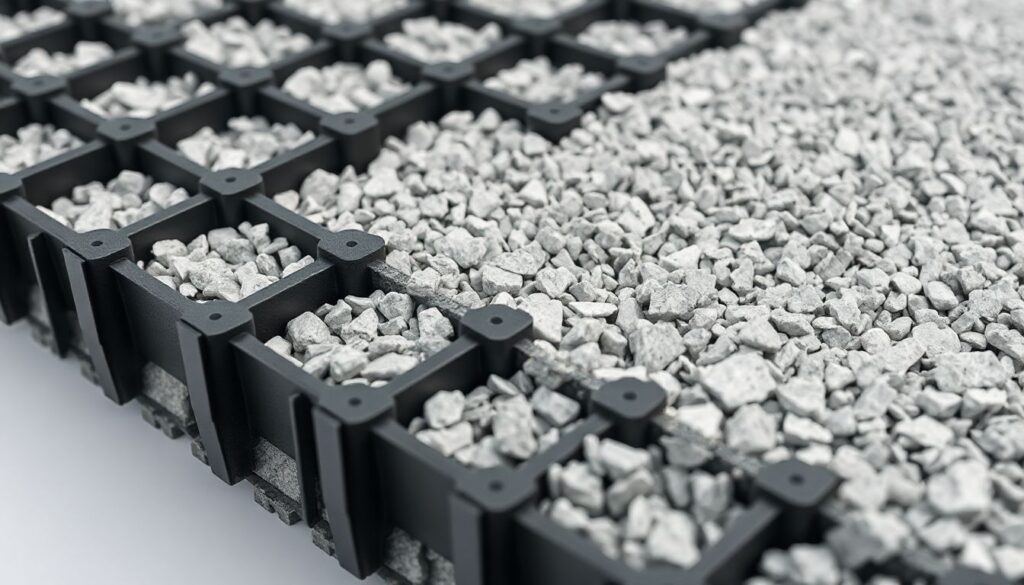Understanding The Problems With Traditional Gravel
Gravel has long been a popular material for driveways, pathways, and landscaping, but it comes with well-known challenges. Over time, gravel sinks into the soil, shifts under foot or vehicle traffic, and forms ruts and uneven patches. Cars carve tracks, rain pushes gravel around, and foot traffic creates dips that constantly need to be refilled. Many people accept these issues as unavoidable, believing gravel will always require frequent upkeep. However, the introduction of gravel grids has completely changed how gravel surfaces perform.
The Structural Design Behind Gravel Grids
Gravel grids are durable interlocking panels made from strong plastic materials such as HDPE. These panels form a honeycomb or cellular pattern that creates individual pockets for gravel to sit in. Instead of resting loosely on the ground, each piece of gravel becomes part of a structured layer. This cellular design is the foundation of how gravel grids prevent sinking and shifting. The grid holds gravel in place, supports it from beneath, and ensures the surface stays level.
How Gravel Grids Reduce Sinking
Traditional gravel sits directly on soil or a loose sub-base. Soil naturally expands, contracts, and shifts, especially with moisture and temperature changes. As the ground moves, the gravel follows, leading to soft spots and depressions. Gravel grids provide a stable barrier between the gravel and the underlying soil. When a vehicle or person applies pressure, that weight is spread across the entire grid rather than concentrated on one area. Because pressure is distributed evenly, the soil does not compress unevenly, and gravel does not sink into the ground.
Preventing Gravel From Shifting Out Of Place
One of the biggest frustrations with gravel is how easily it scatters: turning tires push gravel sideways, braking forces make piles, and even wind and water can break up the surface. Gravel grids solve this by locking gravel into individual cells. Each of these cells works like a container that stops the material from sliding or rolling away. Even when heavy vehicles move across the surface, the gravel stays inside the grid structure. This greatly reduces the need to rake gravel back into place or refill bare areas.
Improving Drainage And Preventing Erosion
Poor drainage is also a major factor contributing to unstable gravel. As the water stands, if it seeps into the soil or otherwise softens the soil, it reduces the strength of the ground surface. The gravel sinks into that weakened soil to create the uneven surface so common for many homeowners. Being permeable, gravel grids allow water to pass through easily. They assist in creating a raised and well-drained layer that inhibits water from accumulating beneath the surface. Since the surface is correctly drained, erosion and washouts are far less likely.
Why Gravel Grids For Driveways Make A Big Difference
Driveways face more pressure than almost any other outdoor surface. Cars repeatedly drive over the same tracks, which causes ruts in loose gravel. Without reinforcement, these ruts become deeper and harder to fix over time. Gravel grids for driveways eliminate this problem by spreading vehicle weight across the entire surface. Tires roll over a supported structure rather than displacing gravel. The result is a driveway that stays level, smooth, and visually consistent, even after years of daily use.
Installation That Enhances Stability
Gravel grids are lightweight and easy to install, but they require quality preparation to ensure the best results. A compacted sub-base forms the solid base that these grids need to work. The gravel is then poured into the cells after laying and interlocking the grids, compacting it thereafter. When properly laid, a finished surface is firm and one that will last. Even sharp turns or sudden stops from vehicles do not disturb the gravel.
A Natural-Looking Yet Stable Surface
One of the immediate benefits of gravel grids is that they remain invisible once filled. You have the look of a natural gravel surface without many of the maintenance issues usually associated with it. Be it for your driveways, garden paths, or parking spaces, it maintains an even and clean look. Gravel stays in its place without scattering onto lawns and flower beds. That keeps the entire area looking neat and well-maintained.
Reduced Maintenance And Long-Term Value
Although gravel grids require an upfront investment, they quickly pay off by reducing long-term maintenance. Without grids, homeowners must regularly rake gravel, add fresh material, and regrade areas that have become uneven. Gravel grids minimize these issues by keeping the gravel where it belongs. Because the surface stays intact longer, significantly less gravel is needed over the years, and the time spent repairing ruts or dips is greatly reduced.
A Reliable Solution For A Stronger Surface
Gravel grids prevent sinking and shifting through a combination of structural support, effective drainage, and smart load distribution. They transform loose gravel into a durable, stable surface that maintains its strength and appearance over time. Whether for a small pathway or a full driveway, gravel grids offer a practical and reliable solution that enhances the performance and longevity of gravel surfaces. For anyone seeking a more stable, low-maintenance alternative, gravel grids provide the strength and consistency that traditional gravel alone cannot offer.

